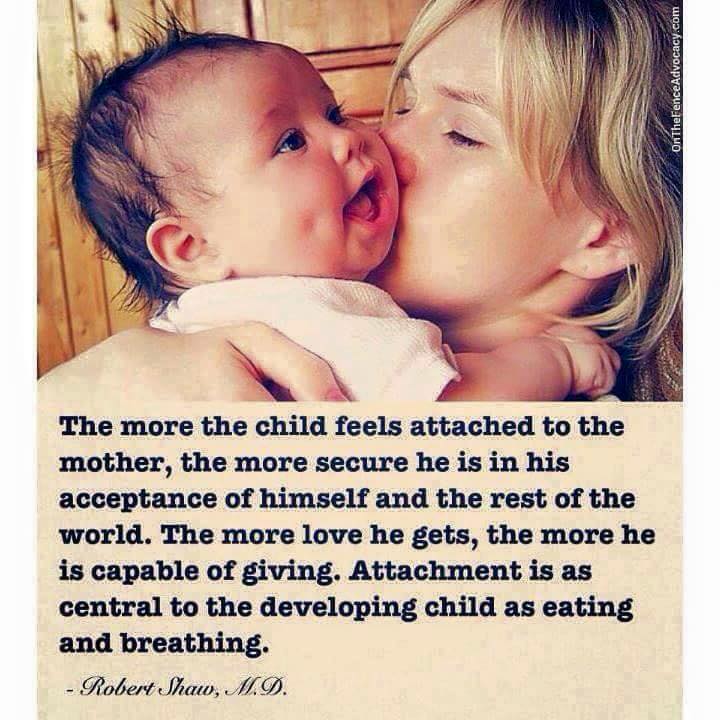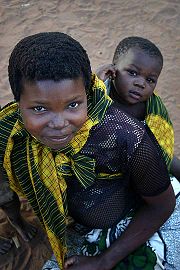
James W. Prescott, Ph.D.
Mother child bonding
(Attachment)
[back] Child health
Birth trauma
[The most important thing for child health. Circumcision must be the main block to this, followed by bottle-feeding (full set: Birth trauma). So full term breastfeeding (2.5 years minimum), carrying for one year, and as much touch and eye contact (avoiding eye contact is still suggested by some pseudo1-experts, 2015) as possible, is the ideal (see: The Family Bed.), while avoiding the Vaccination Racket which is the main cause of autism and Nervous system and other diseases in children.]
See: Birth trauma Undisturbed First Hour
John Bowlby
James W. Prescott, Ph.D.
Bonding or Violence: An Introduction by Michael Mendizza
Ashley Montagu Interview by Michael Mendizza
Why African Babies Don't Cry By J. Claire K. Niala
[2014] EPIDURAL DURING LABOR AND THE ONSET OF BAD MOTHER-CHILD RELATIONSHIPS by Jeanice Barcelo Did you know that when a mother chooses to have an epidural during labor, she is signing up to have her own pain removed, BUT TO CAUSE HER BABY MORE PAIN!!!
[2013] OXYTOCIN, HUMAN LOVE, AND HUMAN BONDING by Jeanice Barcelo Every single hospital birth protocol undermines the capacity for mother, father, and child to bond. Damaging technological interventions disrupt the production of natural oxytocin, and these include (but are not limited to) induction, amniotomy, fetal heart monitors (especially the internal ones that are literally SCREWED into the baby’s skull), the use of cytotec, pitocin, demerol (or any drugs whatsoever) during labor or immediately after birth, c-section, the unnecessary, sadistic, and violent clamping and cutting of the umbilical cord, the theft of infant cord blood, oral suctioning, putting ointment in the baby’s eyes so that his/her eyes burn and he/she cannot make eye contact with his/her parents, infant swaddling (which prevents skin-to-skin contact, restricts all movement, and causes baby to go into parasympathetic shock), highly toxic vaccinations immediately after birth, so-called vitamin k shots, separating mother and child for any length of time during the first hour after birth, neonatal intensive care unit (which are brutal), circumcision, and the list goes on.
[2011 Dec] Dangers of “Crying It Out” by Darcia Narvaez, Ph.D.
[2006] James W. Prescott, Ph.D. letter Dr. Charles H. Halstead, Editor-in-Chief, American Journal of Clinical Nutrition that alerts him to the dangers of infant formula feeding for the formation of the brain neurotransmitters necessary for social bonding and requesting his support for a national review of this subject by DHHS Secretary Leavitt and the urgent need to take corrective actions.
[2002] The Origins of Love & Violence: An Overview by James W. Prescott, Ph.D.
[1975] BODY PLEASURE AND THE ORIGINS OF VIOLENCE By James W. Prescott "primitive" cultures which subject their infants to physical punishment and/or punish premarital sex are 100% violent, whereas cultures which lavish physical affection on their infants and/or tolerate premarital sex are 100% peaceful.
See: Violence Bottle-feeding Circumcision Emotions, feelings (kill) Poisonous pedagogy
Quotes
"I'm reminded of a debate the famous pediatrician
Robert Mendelsohn, MD had with a
psychiatrist. The panellist asked them about the Family Bed (everyone sleeping
together). "It's a terrible idea," said the psychiatrist. "I'd never
sleep with my children. It fosters dependency, it confuses them sexually, it's just plain
wrong." The moderator asked if Dr. Mendelsohn would care to respond. "I agree
with the psychiatrist," said Dr. Mendelsohn. "Psychiatrists should not
sleep with their children. But for everyone else, it's just wonderful. I gives
infants the warmth and security they seek. It enhances emotional health and it
brings the family closer."--Ted Koren DC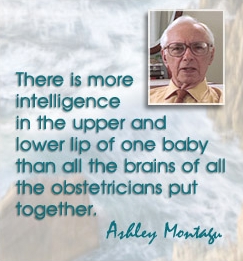
it is the variable of carrying the infant on the body of the mother/caretaker in primitive cultures that is so strongly predictive (80%) of peaceful and non-violent cultures which includes lack of abuse of infants and children. [1989] THE TRUTH ABOUT SEXUAL MONOGAMY by James W. Prescott, Ph.D.
They are expelled rather roughly and usually taken away from their mother, which is wrong. It's physiologically/psychologically wrong. Both baby and mother need each other more at that time than they ever will again. The baby should be put to nurse at his mother's breast whereupon it induces an enormous number of wonderful changes in the mother, such as an arresting of the postpartum hemorrhage, which no obstetrician can do under the circumstances, but a baby can do. Which indicates that there is more intelligence in the upper and the lower lip of one baby than all the brains of all the obstetricians put together. Ashley Montagu Interview by Michael Mendizza
Society must support mothers (and fathers) in being nurturing parents by supporting the continuous carrying of the infant on the body of mother/father throughout the day during the first year of life. [2002] The Origins of Love & Violence: An Overview by James W. Prescott, Ph.D.
Love: what is love? Well, to spell it out briefly, it is the ability to communicate to others your profound involvement in their welfare, such that you will never commit the supreme treason of letting them down, whenever they most stand in need of you, and that you will minister to and encourage the growth and development of their potentialities. That's love. Ashley Montagu Interview by Michael Mendizza
We know that we're all born with physical needs, like the need for oxygen,
for liquid, for rest, activity, sleep, and so on. These must be satisfied if we
are to survive physically. The extraordinary thing is that we're also born with
basic behavioral needs. These are the need for love, about which we know very
little, the need for creativity, the need for sensitivity, the need for
learning, the need for the acquisition of knowledge, the need for play, for
song, for dance, for curiosity, for imagination.
All these are basic behavior needs,
which are as much a part of our genetic system as the physical needs. Yet, we
haven't recognized them. Look at any textbook on the nature of human nature and
you won't find any mention of them.
Ashley Montagu
Interview by Michael Mendizza
Bonding or Violence: An Introduction by Michael Mendizza discovered in the 1960's and 1970's; that lack of affectionate, intimate contact between mothers and infants during the most sensitive periods of brain growth may result in permanent brain abnormalities associated with juvenal and adult patterns of depression, substance abuse, eating disorders, aggression and violence.....Mothers are not valued, nurtured or supported by the culture. Drugs and technological birth practices routinely separate mothers and babies during the most sensitive bonding period. Single parent families, an euphemism for single moms, without the support, mentoring, and nurturing of extended families and communities, routinely place the majority of infants and young children in institutional childcare for extended periods of time, shortly after birth. Lack of initial bonding, institutional childcare, and social pressures, such as work schedules and welfare reform prevent most mothers from bonding with and breast-feeding their babies.
It is the variable of carrying the infant on the
body of the mother/caretaker in primitive cultures that is so strongly
predictive (80%) of peaceful and non-violent cultures which includes lack of
abuse of infants and children.
When the infant physical
affectional variable was combined with permitted pre-marital sexuality my
prediction of peaceful or violent cultures rose to 100% of the 49 cultures where
this information was available. Further, these cultures were matrilineal where
78% of the nine cultures that also had information on extramarital sexuality
also permitted extramarital sexuality. [1989]
THE TRUTH ABOUT SEXUAL MONOGAMY by James W. Prescott, Ph.D.
No mammal on this planet, except the human mammal, separates the newborn from its mother at birth and during the crucial and formative postnatal period of brain-behavioral development. No mammal on this planet, except the human mammal, refuses to breastfeed its newborn and during the crucial and formative periods of breastfeeding for brain-behavioral development that varies with mammalian species. The violation of these two mammalian universals by the human primate-homo sapiens-has brought devastating consequences upon itself in terms of damaged biological and emotional-social health that threatens the very existence of the species. [2002] The Origins of Love & Violence: An Overview by James W. Prescott, Ph.D.
It is worth noting that the bonobo chimpanzee, which is the most peaceful primate on the planet, breastfeed their young to about four years of age; the mother carries her offspring on her body through early adolescence (particularly male offspring); and where multiple male/female sexual relationships are commonplace which are characterized by the lack of aggression or violence (Diamond, 1992; De Waal and Lanting, 1997, Prescott, 2001). [2002] The Origins of Love & Violence: An Overview by James W. Prescott, Ph.D.
Newman (1995) has summarized the essential role of breastfeeding for healthy human development where WHO/UNICEF (1990) have recommended breastfeeding for "two years of age or beyond" that, inexplicably, is not supported by the American Academy of Pediatrics (AAP, 1997). Laudenslager, et al. (1982) have documented impaired immune system development from mother-infant separations (includes lack of breastfeeding). We shall see that breastfeeding of the human primate for 2.5 years or greater is essential to optimize the health benefits (biological and psychosocial) of breastfeeding for child and mother. [2002] The Origins of Love & Violence: An Overview by James W. Prescott, Ph.D.
Watson (1928) in his book Psychological Care of Infant and Child stated: "…a
sensible way of treating children…Never hug and kiss them, never let them sit on
your lap. If you must, kiss them once on the forehead when they say good night."
Luther Emmett Holt (1894), the
leading pediatric authority of his day, stated in his textbook: "To induce
sleep, rocking and all other habits of this sort are useless and may be
harmful"; and later in 1916 advised that the crib should not rock in order that
"the unnecessary and vicious practice may not be carried on". Holt could not
have been in greater error, as we now know that gentle rocking (movement) of the
infant/child is essential for normal brain-behavioral development and bonding.
See
http://www.violence.de/tv/rockabye.html, which was premiered at the 1970
White House Conference on Children.[2002]
The Origins of Love & Violence: An Overview by
James W. Prescott, Ph.D.
Liedloff (1975) has documented the importance of baby carrying and affectional bonding between mother and infant/child in her single culture study. Joseph Chilton Pearce reinforced the significance of bonding in Magical Child (1977): "Bonding is the issue, regardless of age. Bonding is a psychological-biological state, a vital physical link that coordinates and unifies the entire biological system. Bonding seals a primary knowing that is the basis for rational thought." [2002] The Origins of Love & Violence: An Overview by James W. Prescott, Ph.D.
Cook (1996) has provided a review of how infants and nations are placed at risk with early child institutional care that ensures lack of bonding. For over a century we have been given wrongful and disastrous advice by "authorities" in pediatrics and psychology that continues to this day. Ferber (1985), a pediatrician, states: "If your child is like this, you may be comforted to know that headbanging, body rocking, and head rolling are very common in early childhood and, at least at this age, are usually normal. If your child exhibits any of these behaviors there is little need for concern about emotional difficulties or neurological illness" p.193; and "In the infant and young toddler, rhythmic patterns are of little significance and you will not need to intervene" (p.197). [2002] The Origins of Love & Violence: An Overview by James W. Prescott, Ph.D.
In a series of subsequent cross-cultural tribal studies, Dr. Prescott found that 77% of 26 tribal cultures whose weaning age was 2.5 years or longer were rated low or absent in suicidal violence. Further, he found significant differences in suicidal behaviors between cultures with weaning age of 2.0 years or less v 2.5 years or greater. This finding suggests that a critical period of brain development exists at this age to mediate this effect. These and other data suggest that breastfeeding for 2.5 years or longer is required to optimize the health benefits of breastfeeding for child and mother (Zheng, 2000). These breastfeeding effects are undoubtedly mediated, in large part, by the rich presence of the amino acid tryptophan in breastmilk that is deficient in infant formula milk and which is necessary for normal brain serotonin development [2002] The Origins of Love & Violence: An Overview by James W. Prescott, Ph.D.
This issue of duration of breastfeeding for optimal biological and mental-social health is particularly urgent when it is recognized that only 6.8% of American mothers are breastfeeding at 12 months; 2.7% are breastfeeding at 24months; and only 1% at 30 months or more (Hediger, 2001; Prescott, 2001). These statistics on breastfeeding become even more alarming in the light of child and youth suicidal deaths which have doubled in the 5-14 year age group over this past generation and has been the third leading cause of death in the 15-24 year age group over this past generation. Further, for the 5-14 year age group the ratio of suicide rates to homicide rates have consistently increased over this past generation, as follows: 1979--36 %; 1994--60%; 1998--73%. It is also a sobering statistic to note that more children and youth (5-24 year age group) have died from suicidal death in the past ten years (est 55,000) than combat lives lost during the ten year Vietnam War (47, 355). Yet, no memorial has been established for these children of suicidal death. [2002] The Origins of Love & Violence: An Overview by James W. Prescott, Ph.D.
It should be noted that the American Academy of Pediatrics in its 1997 revision of its breastfeeding recommendations did not acknowledge the research studies that confirmed tryptophan deficits in infant formula milk which compromises normal brain development and places infants/children at high risk for the development of depression, impulse dyscontrol, drug abuse and suicidal/ homicidal violence. Further and inexplicably, the AAP did not affirm the recommendations of WHO and UNICEF that breastfeeding should be for "two years of age or beyond" (AAP, 1997; WHO/UNICEF, 1990). What does WHO and UNICEF know that the AAP does not know? [2002] The Origins of Love & Violence: An Overview by James W. Prescott, Ph.D.
These data demand studies to evaluate the harmful effects of infant formula milk upon brain development and behavior compared to breastfeeding for "two years of age or beyond" and to evaluate the history of duration of breastfeeding in child and youth suicides and those with a history of depression and psychiatric medication. The NIH, inexplicably, refuses to conduct these studies. [2002] The Origins of Love & Violence: An Overview by James W. Prescott, Ph.D.
The report of the NICHD (National Institute of Child Health and Human
Development) Study of Early Child Care (SECC) found that infants and very young
children who spend more than 30 hours a week in child care "are far more
demanding, more noncompliant, and they are more aggressive" and "They scored
higher on things like gets in lots of fights, cruelty, bullying, meanness as
well as talking too much, demands must be met immediately", according to
Dr.Belsky, one of the principle investigators" (Stolberg, New York Times, April
19, 2001) (emphasis mine)
Dr. Sarah Friedman, NICHD
Scientific Project Officer was reported as saying ""We cannot and should not
hide the findings but I don't want to create a mass hysteria when I don't know
what explains these results" (Stolberg, 2001). Unfortunately, no measures of
biological stress disorders were incorporated into this study nor was there any
awareness of the early NICHD studies in the 1960s and 1970s, which documented
these behaviors in the maternally deprived young.
[2002] The Origins of Love &
Violence: An Overview by James W. Prescott, Ph.D.
It has yet to be recognized that cruelty, bullying and meanness that terrorizes so many of our children and youth in our elementary schools and high schools have their roots in the emotional trauma of mother-infant/child separations associated with institutionalized day care and from other separations These collective emotional-social traumas are sufficiently great to establish an unstable brain that combined with other stress experiences compels many students to despair and the violent acts of homicide and suicide. It is estimated that some 20% of our nation's students have contemplated suicide at one time or another (Moran, 2000; Silverman, et al 200l; Prescott, 2001). What is wrong with America and American families that drive so many of our youth to depression, despair and suicide? [2002] The Origins of Love & Violence: An Overview by James W. Prescott, Ph.D.

Circumcision
Brit milah “It is hard for a woman
with whom an uncircumcised man has had sexual intercourse to separate from him.
In my opinion, this is the strongest of the reasons for circumcision.” ~
Medieval Jewish Philosopher Moses Maimondes http://www.cirp.org/library/cultural/maimonides/

James W. Prescott, Ph.D.
Circumcision
(male)
TEN PRINCIPLES OF MOTHER-INFANT BONDING by James
W. Prescott, Ph.D.
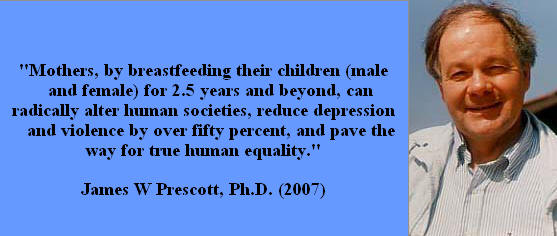
[2007] James W Prescott,
Ph.D.
Violence
Breastfeeding
& Bottle-feeding
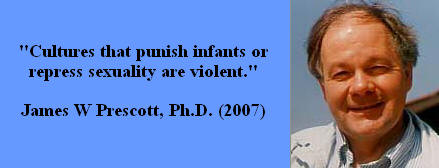
Violence
Suppressing sexuality
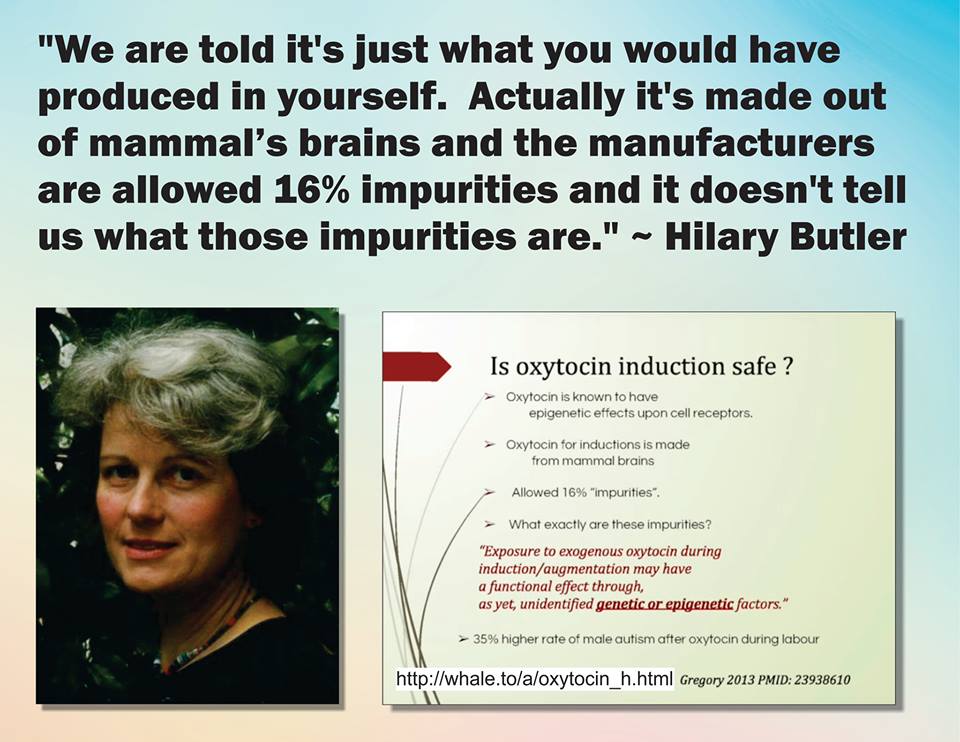
Oxytocin (synthetic)
[vid] Infant Immunity Part III: Birth, placenta, breastmilk with Hilary Butler
"We are told it's just what you would produce yourself.
Actually it's made of mammal brains, and the manufacturers are allowed 16%
impurities, and it doesn't tell us what those impurities are." ~
Hilary Butler

